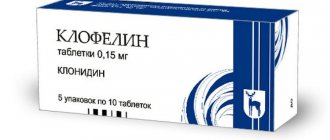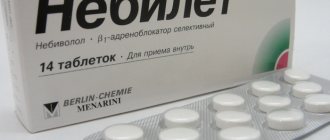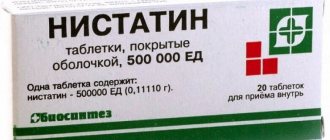Vazar is a drug that has a hypotensive effect, in other words, it lowers blood pressure.
The active component of Vazara is valsartan, Vazara N is valsartan plus hydrochlorothiazide, which enhances the effect of the drug. Excipients are: lactose monohydrate, povidone, croscarmellose sodium, colloidal silicon dioxide, talc, microcrystalline cellulose and magnesium stearate.
The drug Vazar is available in the form of film-coated tablets that are taken orally. Depending on the concentration of the active component, the medicine is yellow (Vazar 40 mg, Vazar 160 mg), pink (Vazar 80 mg) colors.
The drug Vazar N has an additional component hydrochlorothiazide added in volumes from 0.0125 to 0.025 grams, which enhances the hypotensive effect.
Release form and composition
The drug is produced in the form of film-coated tablets: Vazar 40 and Vazar 160 - yellow, Vazar 80 - pink (10 pieces in blister packs, 3 or 9 packs in a cardboard box and instructions for use of Vazar).
Composition of 1 tablet:
- active substance: valsartan – 40, 80 or 160 mg;
- auxiliary components: talc, magnesium stearate, lactose monohydrate, croscarmellose sodium, microcrystalline cellulose, povidone, colloidal silicon dioxide.
Oral tablets Vasar
Instructions for medical use of the drug
Description of pharmacological action
Angiotensin II is an active hormone of the renin-angiotensin-aldosterone system and is formed under the influence of ACE from angiotensin. Its action is to directly and indirectly influence blood pressure through a pressor effect and reduce sodium excretion from the body.
Indications for use
The drug is indicated for arterial hypertension, diseases of the cardiovascular system, accompanied by symptoms of chronic heart failure.
Release form
tablets, 40 mg blister, No. 30
Pharmacodynamics
Vazar, whose active ingredient is valsartan, is an angiotensin II receptor antagonist for oral use. It selectively affects the receptors responsible for the action of angiotensin II. Valsartan affects cardiovascular regulation and does not bind or block other hormonal receptors or ion channels. The hypotensive effect of the drug is observed within two hours, the maximum reduction in blood pressure is achieved within 4-6 hours after taking a single dose of the drug. After taking the drug, the antihypertensive effect is observed for one day. With a course of taking the drug, the maximum reduction in blood pressure is achieved within 2-4 weeks and is subsequently maintained throughout the entire course of treatment. An additional reduction in blood pressure is achieved by adding hydrochlorothiazide to valsartan. Stopping the drug is not accompanied by the development of withdrawal syndrome. With repeated administration of the drug, a slight accumulation is observed.
Pharmacokinetics
After oral administration, the drug is quickly absorbed. The absolute bioavailability of the drug is 23%. Valsartan is bound to plasma proteins. After oral administration, up to 83% of the drug is excreted unchanged in feces and 13% in urine.
Use during pregnancy
Vazar is contraindicated during pregnancy and lactation.
Contraindications for use
Prescribing and taking the drug is contraindicated in case of hypersensitivity to valsartan or the excipients included in Vazar, severe liver dysfunction, cirrhosis, impaired bile outflow, impaired renal function, hemodialysis.
Side effects
Side effects of the drug Vazar include orthostatic hypotension, infections of the upper respiratory tract and paranasal sinuses - sinusitis, pharyngitis. In rare cases, conjunctivitis, hypotension, heart failure, cough, abdominal pain, diarrhea, back pain, myalgia, arthritis, asthenia, and headache may develop. The development of neurological disorders in the form of depression, insomnia, neuralgia, and syncope is possible. A blood test may reveal hyperkalemia and thrombocytopenia, leading to the development of nosebleeds and bleeding of other locations. In exceptional cases, acute renal failure and other renal dysfunction, gastroenteritis, and angioedema are possible.
Directions for use and doses
The average therapeutic dose of Vazar for arterial hypertension is 0.16 g once a day, which, if necessary, can be increased to 0.32 g once a day. Concomitant use of the drug with other antihypertensive drugs is possible. The initial dose of the drug for chronic heart failure is 0.04 g twice a day, which is gradually increased to 0.16 g twice a day. The initial dose of Vazar in the post-infarction period of myocardial infarction is 0.02 g twice a day, which is gradually increased to 0.16 g twice a day.
Overdose
A symptom of a possible overdose of Vazar is arterial hypotension, which is accompanied by dizziness. If hypotension develops, it is recommended to place the patient in a horizontal position and administer saline solutions parenterally. Prescribing dialysis is not advisable, since the drug is bound in significant quantities by blood plasma proteins.
Interactions with other drugs
Prescribing potassium supplements, potassium-sparing diuretics, and drugs that increase potassium levels with Vazar requires caution and measurement of potassium concentration in the blood. Co-administration with Vazar of indomethacin, cimetidine, furosemide, atenolol, digoxin, hydrochlorothiazide, warfarin, amlodipine and glibenclamide, used to treat arterial hypertension, does not lead to the development of their interactions. When prescribing other antihypertensive drugs, the antihypertensive effect of Vazar may be increased. The use of nonsteroidal anti-inflammatory drugs leads to a decrease in the hypotensive effect and impaired renal function, which is reversible and temporary. In rare cases, patients with impaired renal function and elderly patients may develop acute renal failure.
Special instructions for use
The drug requires careful use in patients with renal artery stenosis, in case of simultaneous use of potassium supplements and potassium-sparing diuretics. When diuretics are used in large doses, symptomatic hypotension may develop against the background of reduced sodium levels and circulating blood volume. Careful prescribing and medical supervision are necessary at the initial stage of treatment of chronic heart failure, in the post-infarction period, with liver cirrhosis, and simultaneous prescription of ACE inhibitors. For liver diseases, the dose of the drug should not be higher than 0.08 g. The use of Vazar for the treatment of children and adolescents has not been studied.
Storage conditions
It is recommended to store Vazar in a dry, dark place at temperatures up to 25 degrees Celsius.
Best before date
24 months
ATX classification:
C Cardiovascular system
C09 Drugs affecting the renin-angiotensin system
C09C Angiotensin II antagonists
C09CA Angiotensin II antagonists
C09CA03 Valsartan
Pharmacological properties
Pharmacodynamics
The active ingredient of Vazar tablets is valsartan, an angiotensin II receptor antagonist, which is an active hormone of the renin-angiotensin-aldosterone system and is formed under the action of angiotensin-converting enzyme (ACE) from angiotensin. It has a direct and indirect effect on blood pressure, having a pressor effect and reducing sodium excretion from the body. Valsartan selectively affects the receptors responsible for the action of angiotensin II.
Vasar affects cardiovascular regulation and does not block or bind other ion channels or hormonal receptors. The antihypertensive effect of valsartan develops within 2 hours, the maximum decrease in blood pressure (BP) is observed within 4–6 hours after a single dose of the drug and persists throughout the day.
With a course of taking the drug, the maximum reduction in blood pressure is achieved within 2–4 weeks and is subsequently maintained throughout the entire course of therapy. If additional blood pressure reduction is necessary, hydrochlorothiazide is added to valsartan.
When valsartan is taken again, a slight accumulation of the substance is observed. Cancellation of Vazar is not accompanied by the development of withdrawal syndrome.
Pharmacokinetics
Once in the gastrointestinal tract, valsartan is quickly absorbed. Its absolute bioavailability is 23%. Bonding with plasma proteins is 94–97%.
The drug is excreted unchanged from the body through the intestines (83%) and kidneys (13%).
Overdose of the drug Vazar N, symptoms and treatment
There is no data regarding an overdose of valsartan or its combination with hydrochlorothiazide. The main sign of an overdose may be arterial hypotension with dizziness. Treatment depends on the time elapsed after taking the drug and the severity of symptoms, with hemodynamic stabilization being most important. If hypotension occurs, the patient should be transferred to a horizontal position and parenteral administration of saline solutions should be provided as soon as possible. Valsartan is not eliminated by dialysis due to significant binding to plasma proteins.
Contraindications
- Impaired kidney function and bile flow;
- Cirrhosis of the liver;
- Severe functional liver disorders;
- Pregnancy and lactation;
- Hypersensitivity to components.
Vazar is contraindicated in patients undergoing hemodialysis.
Vazar tablets should be taken with caution in patients with renal artery stenosis while taking potassium supplements and potassium-sparing diuretics at the initial stage of treatment of CHF (chronic heart failure), while prescribing angiotensin-converting enzyme (ACE) inhibitors, in the post-infarction period.
Pharmacological action of Vazar
The active component of Vazar helps lower blood pressure. The maximum therapeutic effect is observed 4-5 hours after oral administration of the drug and lasts for about 2 hours. During the day after taking the medicine, the pressure is at a reduced level, but for the best and stable result it is recommended to take Vazar tablets regularly for at least 2 weeks.
To enhance the effectiveness of the drug, patients are prescribed its variety - Vazar N.
The drug does not cause dependence or withdrawal symptoms. With a repeated course of treatment, slight cumulation (accumulation of a biologically active substance or the effects it produces upon repeated administration) can be observed.
The drug is quickly absorbed by the gastrointestinal tract. The absolute bioavailability of the drug is 23 percent. The active component binds to blood plasma proteins. The drug is excreted unchanged from the body in feces (up to 83 percent) and urine (about 13 percent).
Vazar, instructions for use: method and dosage
For arterial hypertension, the drug is taken once a day. The average therapeutic dose of Vazar is 160 mg, which can be doubled if necessary. Concomitant use of other antihypertensive drugs is possible.
For chronic heart failure, the initial dose of the drug is 40 mg 2 times a day. If necessary, the dose can be gradually increased to 160 mg 2 times a day.
After myocardial infarction, the initial dose is 20 mg 2 times a day. It is gradually increased to 160 mg 2 times a day.
Indications for use of Vazar
According to the instructions, Vazar is prescribed for the treatment of:
- symptomatic heart failure, in which the use of ACE inhibitors is impossible (or as part of complex therapy with ACE inhibitors, when the use of beta-blockers is impossible);
- symptomatic heart failure in clinically stable patients;
- asymptomatic left ventricular systolic dysfunction after recent (from 12 hours to 10 days) myocardial infarction;
- arterial hypertension of all forms.
Side effects
When using Vazar, the following side effects may develop:
- Attachment of infections of the paranasal sinuses and upper respiratory tract (pharyngitis, sinusitis);
- Orthostatic hypotension.
In some cases, during therapy the following may occur: heart failure, hypotension, diarrhea, abdominal pain, cough, back pain, arthritis, myalgia, asthenia, headache, conjunctivitis.
The development of neurological disorders in the form of insomnia, depression, syncope, and neuralgia is possible. Hyperkalemia and thrombocytopenia may occur, leading to nosebleeds and bleeding of other locations.
It is extremely rare to develop during treatment: angioedema, acute renal failure and other functional disorders of the kidneys, gastroenteritis.
Adverse reactions
What are the undesirable consequences of using Vazar N 80? The most common complication (1 in 10 cases) is headache.
With a frequency of 1 in 100 cases there are:
- slight dizziness;
- inflammation of the upper respiratory tract (sinusitis, pharyngitis, rhinitis), often of viral etiology;
- cough, bronchitis, shortness of breath;
- difficulty falling asleep and staying asleep, increased fatigue;
- decreased blood pressure, especially when taking alcohol, sedatives and anesthetics;
- joint and muscle pain, cramps;
- loss of appetite, nausea and vomiting, pain in the stomach and abdomen, upset stool, dyspepsia;
- frequent urination, decreased potency, urinary tract infections;
- visual disturbances, conjunctivitis;
- decrease in potassium in the body;
- increased serum creatinine;
- skin rash, urticaria.
Sometimes (up to 1/1000) Vazar N 80 gives a decrease in libido, severe dizziness, and an asthenic state. Rarely (1/10,000) depression, arrhythmia, parasthesia, cramps in the lower extremities, constipation, jaundice, and decreased platelet levels occur.
Very rarely (1\100000) possible:
- inflammation and edema of the lung;
- inflammation of the pancreas;
- suppression of bone marrow function, agranulocytosis;
- hemolytic anemia;
- vasculitis, angioedema, epidermal necrolysis.
special instructions
Caution is required when using tablets in patients with renal artery stenosis in case of simultaneous use of potassium-sparing diuretics and potassium supplements.
The use of large doses of diuretics can cause symptomatic hypotension (with reduced circulating blood volume and sodium levels).
At the initial stage of treatment of chronic heart failure, in the post-infarction period and with the simultaneous administration of ACE inhibitors, careful use of Vazar and medical supervision is required.
For liver diseases, the maximum permissible dose of Vazar is 80 mg.
The role of the renin-angiotensin-aldesterone system (RAAS) in blood pressure regulation
Renin is a biologically active substance, a proteolytic enzyme produced by cells of the juxtaglomerular apparatus of the kidneys. Under its influence, the inactive angiotensinogen in the blood plasma turns into an active form - angiotensinogen 1. It does not affect the change in pressure, however, when exposed to angiotensin-converting factor, it turns into angiotensin 2, which has a powerful vasoconstrictor effect and increases the production of aldosterone, which contributes to the reverse absorption of sodium in the renal tubules.
Sodium is able to “attract” water, this leads to an increase in the volume of fluid inside the vascular bed, therefore, to an increase in pressure. The work of the RAAS is influenced by neurohumoral regulation and is responsible for blood pressure, circulating blood volume, water and electrolyte balance, thirst and drinking behavior.
An increase in pressure in the afferent vessels gives a command to reduce the production of renin. This means that the conversion of angiotensinogen to angiotensin 1 and then angiotensin 2 is reduced. The effect of increasing blood pressure of angiotensin 2 is due to its interaction with certain receptors scattered throughout all tissues.
Drug interactions
When using Vazar simultaneously with potassium-sparing diuretics, potassium preparations, and drugs that increase potassium levels, you must be careful and measure the concentration of potassium in the blood.
When combined with cimetidine, indomethacin, atenolol, furosemide, warfarin, digoxin, hydrochlorothiazide, glibenclamide and amlodipine, used to treat arterial hypertension, no interaction is observed.
When prescribing other antihypertensive drugs, the antihypertensive effect of Vazar may be increased.
The simultaneous use of non-steroidal anti-inflammatory drugs with valsartan leads to a decrease in the hypotensive effect and impaired renal function (it is temporary reversible). In some cases, patients with impaired renal function and elderly patients may develop acute renal failure.
Interactions of the drug Vazar N
When concomitantly using potassium supplements, potassium-sparing diuretics, salt supplements containing potassium, or other drugs that may increase potassium levels (heparin, etc.), caution should be exercised and blood potassium concentrations should be monitored. No clinically significant interactions were observed with drugs commonly used to treat patients with hypertension: cimetidine, warfarin, furosemide, digoxin, atenolol, indomethacin, hydrochlorothiazide, amlodipine and glibenclamide. Other antihypertensive drugs may increase the antihypertensive effect of valsartan. Long-term use of NSAIDs may reduce the antihypertensive effect of angiotensin II antagonists. NSAIDs and angiotensin II antagonists have an additive effect on increasing serum potassium levels and may lead to renal impairment. This effect is usually reversible. Rarely, the development of acute renal failure is possible, in particular in patients with already impaired renal function - patients with dehydration, the elderly. When using Vazar N, which contains hydrochlorothiazide, the following drug interactions are potentially possible: thiazides increase the effect of curare-like muscle relaxants; it is possible to reduce the diuretic and antihypertensive effect of hydrochlorothiazide when used simultaneously with NSAIDs (for example, acetylsalicylic acid, indomethacin). Concomitant hypovolemia can lead to the development of acute renal failure; the risk of developing hypokalemia increases with simultaneous use of saluretics, corticosteroids, ACTH, amphotericin B, carbenoxolone, penicillin G and salicylic acid derivatives; thiazide diuretics can cause side effects such as hypokalemia or hypomagnesemia, which increases the risk of arrhythmia due to glycoside intoxication; When using hydrochlorothiazide, there may be a need to adjust the dose of insulin or an oral hypoglycemic agent.
Reviews
The drug Vazar is able to quite quickly and effectively reduce blood pressure, and therefore deserves many positive reviews.
People who have taken these tablets note the rapid and long-lasting effect, as well as the affordable cost.
In some cases, side effects develop, but they are mainly associated with incorrect dosages.
You can read the reviews in detail at the end of the article. You also have the opportunity to share your own opinions about the medicine with other site visitors.
Consequences of overdose
If the maximum possible dose of the drug “Vazar N”, “Vazar 80”, “Vazar 160” is exceeded, the instructions (the price of medications will be discussed below) recommend the following. Since an overdose can cause the development of arterial hypotension, which is usually accompanied by dizziness, the patient must take a horizontal position, after which he is injected with the necessary saline solutions (parenterally).
Due to the fact that valsartan actively binds to blood proteins, dialysis will not provide any positive effect.
Pharmacokinetic indicators
Where is the absorption of the drug “Vazar N” (160)? The instructions for use state that valsartan is instantly absorbed from the gastrointestinal tract. Moreover, the degree of its absorption is variable.
The bioavailability (absolute) of this component is 23%, and the connection with plasma proteins is 95-97%. Valsartan is excreted through the intestines and kidneys.
Hydrochlorothiazide is also very quickly absorbed from the intestine. Its peak concentration is reached after 120 minutes, and its bioavailability is 65-85%.
The half-life of the substance in question varies between 6-15 hours (via the kidneys).
Contraindications and precautions
These include:
- history of liver cirrhosis
- congestion in the bile ducts
- period of pregnancy and breastfeeding
- problems with renal function, taking into account hemodialysis
- individual intolerance, hypersensitivity.
Cross-drug interactions
Simultaneous use with potassium-sparing diuretics or drugs with potassium requires monitoring of blood counts to avoid an excess of the macroelement. Other drugs with a pronounced hypotensive effect are not recommended for combined use. The simultaneous use of non-steroidal anti-inflammatory drugs along with the drug helps to reduce its effect, additionally loads the kidneys, and in old age contributes to the development of deterioration of renal functionality.
Opinions about the drug
As for Vazar 80, reviews of it from both medical workers and patients are mostly positive. The drug has proven itself to be an effective remedy in the treatment of arterial hypertension. “Vazar 160” also did not cause a wave of criticism.
According to patients, it has an effect not only when taking the full dose of 160 mg, but also reduces blood pressure when taking half or even a quarter of the dose in cases where the patient's condition is not severe and the drug is well tolerated.
There are also negative reviews about Vazar in the sense that the drug has caused the development of unwanted side effects. Most often, the problem lies either in individual hypersensitivity to the components of the drug, or in an incorrectly selected dose. In this case, it is recommended to contact the attending physician, because only he bears responsibility for the patient’s health, both in the case of choosing the wrong dose and when prescribing Vazar and not anything else.
Analogs
Lorista
KRKA, Slovenia
The average cost of the drug is 500 rubles per package.
Lorista is a drug for the treatment of high blood pressure. It is used to prevent stroke in the presence of chronic heart failure, and is also useful for people who develop proteinuria due to diabetes. The drug is available in tablet form. It has a moderate list of contraindications. It has a sufficient number of possible side effects. There is a release form with and without a diuretic. It is usually well tolerated and helps maintain normal health when taken regularly.
Pros:
- widely available commercially
- helps a lot.
Minuses:
- many side effects
- expensive.
Nortivan
Gedeon Richter LLC, Poland
The average cost of the drug in Russia is 400 rubles.
This is a drug that effectively reduces blood pressure. Helps prevent the transition of angiotensin type 1 to type 2. It is used primarily to support the body against the background of the development of heart failure, diabetic nephropathy and left ventricular failure after myocardial infarction. The product should not be used for liver diseases, as it burdens it. It has a large list of side effects.
Pros:
- convenient release form
- helps a lot.
Minuses:
- many side effects
- difficult to find on sale.
Candesartan
CJSC Northern Star, Russia
The average cost of the drug is 320 rubles per package.
Candesartan is a drug to combat hypertension. The mechanism of action is to inhibit type 2 angiotensin, which has a vasoconstrictor effect. The medicine has a cumulative effect, which is revealed after 1 - 1.5 months from the start of therapy. Does not have high bioavailability. Release form: tablets.
Pros:
- suitable for long-term use
- convenient to use.
Minuses:
- hard to find on sale
- has a sufficient list of side effects.
Price range
Prices for medications vary greatly depending on the region, the volume of the active component contained in the tablet and, in fact, the number of tablets in the package. For example, in Moscow “Vazar 80” (30 tablets per package) will cost the consumer from 240 to 350 rubles. However, another, more often used dosage is in greatest demand among buyers (at least, this is what the instructions say about the medication “Vazar 160”). The price of the drug - 30 tablets will cost from 450 to 500 rubles - is not that low, but with the prescribed daily dose of 40, 80 mg, they will last for a much longer period of time than if a person bought Vazar 80 . That is, from an economic point of view, purchasing package No. 30 with a dose of 160 mg is more profitable than the same 30 tablets, but with a dosage of 80 mg.
Similar drugs:
- Carsil Dragee
- Ascorutin Oral tablets
- Yogurt Capsule
- Ergoferon () Lozenges
- Magne B6 Oral tablets
- Omez Capsule
- Papaverine Oral tablets
** The Drug Directory is intended for informational purposes only. For more complete information, please refer to the manufacturer's instructions. Do not self-medicate; Before starting to use the drug Vazar, you should consult a doctor. EUROLAB is not responsible for the consequences caused by the use of information posted on the portal. Any information on the site does not replace medical advice and cannot serve as a guarantee of the positive effect of the drug.
Are you interested in the drug Vazar? Do you want to know more detailed information or do you need a doctor's examination? Or do you need an inspection? You can make an appointment with a doctor - the Euro lab is always at your service! The best doctors will examine you, advise you, provide the necessary assistance and make a diagnosis. You can also call a doctor at home . Euro lab clinic is open for you around the clock.
** Attention! The information presented in this medication guide is intended for medical professionals and should not be used as a basis for self-medication. The description of the drug Vazar is provided for informational purposes and is not intended for prescribing treatment without the participation of a doctor. Patients need to consult a specialist!
If you are interested in any other drugs and medications, their descriptions and instructions for use, information about the composition and form of release, indications for use and side effects, methods of use, prices and reviews of drugs, or you have any other questions and suggestions - write to us, we will definitely try to help you.
Medicinal properties
The drug has antihypertensive properties. Valsartan is an angiotensin type 2 receptor blocker. When it is suppressed, the amount of angiotensin of the first type increases, which has a positive effect on reducing blood pressure. The product does not affect hormonal parameters and ion channels. A decrease in blood pressure after oral administration occurs after 2 hours. Maximum action and effect develop after 5 hours. The duration of the effect is one day. When taken daily without skipping, a stable effect develops after 3 weeks of use.
If Vazar is not suitable, then they can prescribe its enhanced version - Vazar n, which lowers blood pressure more strongly, since it contains the diuretic hydrochlorothiazide. The drug is not addictive, and after its withdrawal there is no negative reaction from the body, but with prolonged use there is a slight accumulation of the substance in the body. When taken orally, good absorption of the drug from the gastrointestinal tract is observed. Bioavailability does not exceed 25%. The degree of binding varies within 95%. 90% of the product is excreted in feces, the rest in urine.









